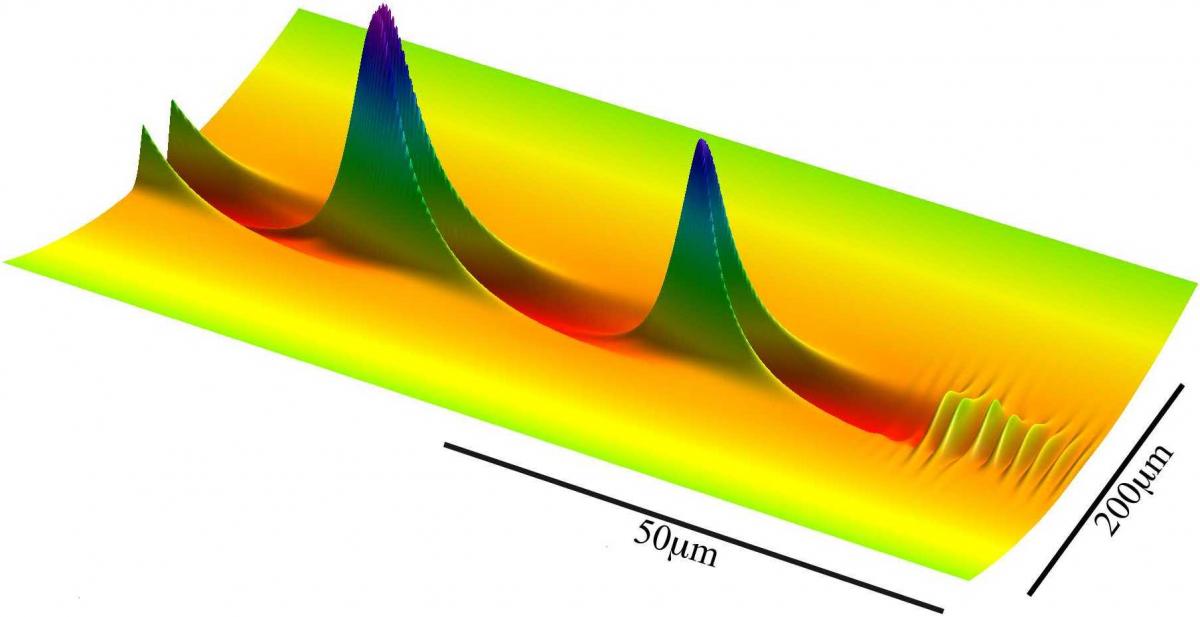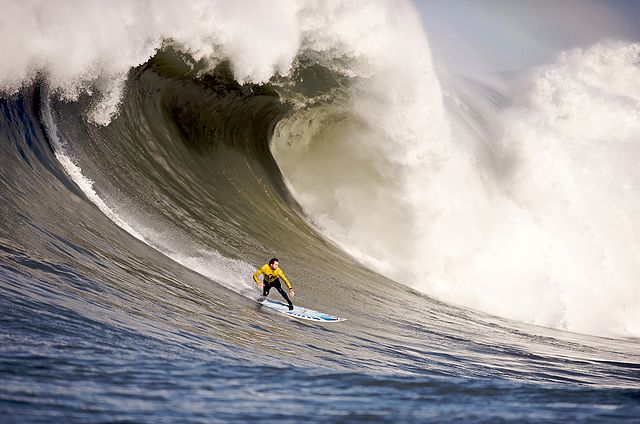Laser-Wakefield Acceleration

The figure shows a simulation of a plasma wave trailing a laser pulse, where the color indicates electron density. The laser is moving from left to right. In the simulation, it can be seen on the right where the electron density is modulated due to its electric field. Simulation courtesy of Brad Shadwick, UNL.
Relativistic particle beams are a unique tool to explore the frontiers of physics: whether they are used in a particle collider to investigate the subatomic world, or to generate radiation that allows to study the structure and dynamics of atoms and molecules. However, conventional accelerators that are used to generate relativistic particle beams are typically on the kilometer-scale in size and on the hundreds of million to billions dollar in cost.
In recent years, a novel electron acceleration method based on high-power lasers as driver has emerged. This scheme allows a more than 3 orders of magnitude of reduction in size as well as a significant reduction in cost. Persistent theoretical and experimental efforts have led to the demonstration of high-quality electron beams with energies of few Giga-electronVolt (GeV) from an acceleration distance of only a few cm, where typical conventional machines require a length of several tens of meters.

Photograph: courtesy of Shalom Jacobovitz.
In these so-called laser-wakefield accelerators (LWFAs), a high-power laser is focused into a gas target, where it generates a plasma. As the laser travels through the plasma, it is trailed by a wave in its wake, just like a boat on a calm lake. In this case, however, the wave consists of electrons and not of water molecules and the laser is moving at almost speed of light. If the laser intensity is sufficiently high, the wave amplitude can increase to the point where it starts to break. Similar to a surfer at the beach, electrons can get injected into the wake and can get accelerated by "surfing" the wave. Since the accelerating field associated with the plasma wave is so immense (and traveling at almost speed of light), the injected electrons get rapidly propelled to relativistic energies -over a distance of only a few millimeters to centimeter.
The accelerated electron bunch is ejected from the plasma into a well-collimated narrow forward cone with beam parameters comparable to (and in some regards even better than) those of conventional accelerators. Moreover, the duration of the electron pulse of LWFAs is of an intrinsically ultrashort timescale which has recently been experimentally verified to be approximately 3 fs (10-15 s).
These properties make LWFA electron pulses the ideal driver for a compact, high-brilliance, ultrafast X-ray lightsource.
Relevant Publications
- Generation of stable, low-divergence electron beams by laser-wakefield acceleration in a steady-state-flow gas cell
J. Osterhoff, A. Popp, Zs. Major, B. Marx, T. P. Rowlands-Rees, M. Fuchs, M. Geissler,R. Hörlein, B. Hidding, S. Becker, E. A. Peralta, U. Schramm, F. Grüner,D. Habs,F. Krausz,S. M. Hooker, and S. Karsch
Phys. Rev. Lett. 101, 085002 (2008) - GeV-scale electron acceleration in a gas-filled capillary discharge waveguide
S. Karsch, J. Osterhoff, A. Popp, T. P. Rowlands-Rees, Zs. Major, M. Fuchs, B. Marx, R. Hörlein, K. Schmid, L. Veisz, S. Becker, U. Schramm, B. Hidding, G. Pretzler, D. Habs, F. Grüner, F. Krausz, S. M. Hooker
New Journal of Physics 9, 415 (2007) - All-optical steering of laser-wakefield-accelerated electron beams
A. Popp, J. Osterhoff, Zs. Major, R. Hörlein, M. Fuchs, R. Weingartner, T. P. Rowlands-Rees, J. Vieira, M. Marti, R. A. Fonseca, L. O. Silva, S. M. Hooker, F. Grüner, F. Krausz, and S. Karsch
Phys. Rev. Lett. 105, 215001 (2010) - Density measurement in a laser-plasma-accelerator capillary using Raman scattering
T. Weineisen, B. Göppner, K. Schmid, M. Fuchs, H. Schröder, S. Karsch, F. Grüner
Phys. Rev. ST Accel. Beams 14, 050705 (2011) - Imaging laser-wakefield accelerated electrons using miniature magnetic quadrupole lenses
R. Weingartner, M. Fuchs, A. Popp, S. Raith, S. Becker, S. Chou, M. Heigoldt, K. Khrennikov, J. Wenz, T. Seggebrock, B. Zeitler, Zs. Major, J. Osterhoff, F. Krausz, S. Karsch, and F. Grüner
Phys. Rev STAB 14, 052801 (2011)